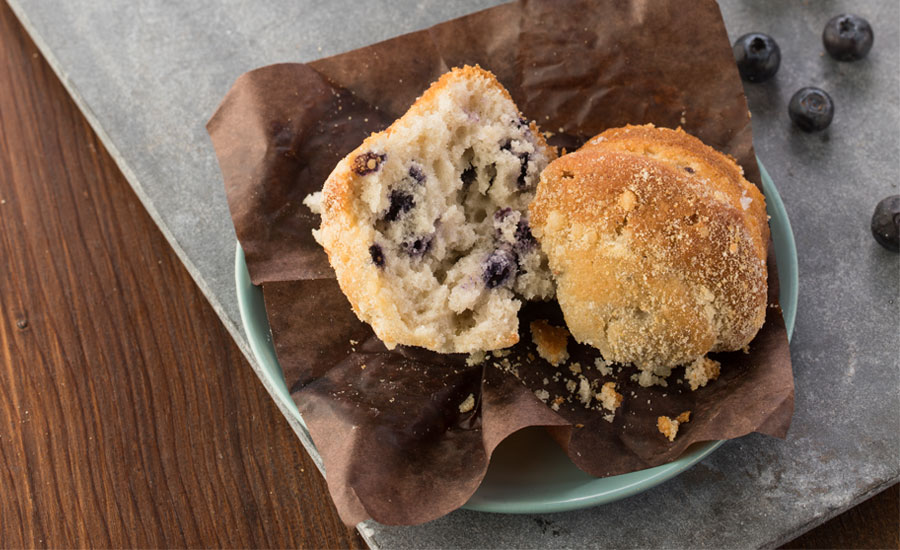The muffins sector is doing very well this year, in both the “center store muffins” and “perimeter muffins” categories. This might be an indicator of either its grab-and-go popularity or perhaps people gathering more to share large orders of muffins.
Market data
According to Chicago-based market research firm IRI’s data from the past 52 weeks, which ended on November 6, 2022, the center store muffins category brought in $1.1 billion in sales, with a 17.4% change versus the previous year.
The “center store mini muffins” subcategory brought in $840 million, with a healthy 20.4% increase from the year before, and the “center store full-size muffins” subcategory brought in $269 million, with a 9.1% increase in sales.
The “perimeter muffins” category brought in $1.163 billion in sales, with a 20.8% increase from last year. The “perimeter full-size muffins” subcategory brought in $945 million, with a 21.5% increase from 2021, and the “perimeter mini muffins” subcategory brought in $150 million, with a hefty 27.7% increase.
The “perimeter assorted/multi-pack muffins” subcategory brought in $66 million, with a small .1% decrease in sales, and the “perimeter muffin trays” subcategory brought in $624,000, with an 84.8% increase, which is perhaps because consumers are returning to work and other places or events where a larger number of muffins are consumed.
Recent trends
“With their portability and flavor appeal, muffins are #1 in the morning baked goods segment,” says Paul Stippich, marketing director, Otis Spunkmeyer (an Aspire Bakeries brand), Los Angeles.
“Research shows that 70% of operators feature muffins as a core morning menu offering—even more than doughnuts or cinnamon rolls. While muffins continue to be a morning staple, with 63% of muffin consumption taking place during breakfast, they also make a great snack and convenient grab-and-go option. Consumers’ growing preference for name-brand ingredients in prepared foods provides an opportunity for in-store supermarket bakeries to offer a brand that consumers know and trust,” he explains.
“The top four flavors for Otis Spunkmeyer muffins are blueberry, banana nut, chocolate chip, and double chocolate. Flavor preferences have closely followed the pandemic trend towards comfort foods. These more traditional flavor profiles reveal that consumers prefer classic tastes, but they must be fresh, rich, and smell delicious,” Stippich notes.
“While there’s always an eye toward innovation, at Otis Spunkmeyer, we focus on these favorite flavors as our core offering to meet consumer demand and help operators grow their business,” he adds. “Trends around consumer purchasing habits and motivations point to the primary purchase drivers for muffins: fresh baked; easy to eat; and great aroma.”
Jennifer M. Puccini, retail account manager, Alpha Baking Company, Chicago, says because Alpha operates in a wide variety of markets, it is able to stay on top of emerging customer trends across the country, from foodservice to retail.

“In addition to the knowledge our sales force brings to the table simply by being out in the field, our marketing department researches current and growing flavor and menu trends. Finally, our research and development labs take the trend information gleaned from sales and marketing and transforms it into new and exciting products that will resonate with consumers. That said, we also love partnering with customers who bring us their ideas for new product development,” she notes.
Sarah Bishop, marketing and sales operation director, Flax4Life, Bellingham, WA, says that per SPINS, the natural, better-for-you muffin category is up 15% over last year's sales and has steadily climbed over the previous couple of years.
“This data suggests that consumers are reaching for a more functional food versus your standard bakery muffin. People want their food to do more for them than just fill their bellies and satisfy their sweet cravings,” she comments.
In addition, she is seeing a reduction in package size across all industries and categories, and the industry will most likely see this in the muffin category, she predicts.
Changes and challenges
“With COVID-19 came a surge in demand for individually wrapped muffins, which we fulfilled with our 2.25-oz. and 4-oz muffins,” says Stippich. “The added safety and ease of service, especially when many operators were facing labor shortages, have been a huge benefit. Otis Spunkmeyer offers all thaw and serve products, so minimal labor and preparation are needed.”
Other elements driving its individually wrapped muffin sales were the trends toward impulse purchasing and increased consumer demand for comfort foods during a challenging time, he notes. He also saw a rise in muffin sales at C-Stores as a key part of their growing foodservice programs.
“To ensure that our brands remain relevant and continue to fulfill the ever-changing needs of operators and consumers, we conduct primary research and subscribe to secondary insights. This is important as a leader in the industry, as these insights have enabled us to adapt to new trends and help our operator customers succeed, even in tough times. We will continue working to bring consumers what they crave and operators what they need to be successful,” Stippich explains.
COVID-19 forced Otis Spunkmeyer to adapt and make changes, he shares. “Fortunately, Aspire Bakeries has one of the leading and broadest bakery footprints in North America. This broad network, our brand, and the ability to meet a high spike in demand enabled us to position Otis Spunkmeyer well in the market and deliver for our operator partners, even throughout these challenges.”
Puccini says due to the pandemic, Alpha experienced shortages on some key ingredients needed for sweet goods production, and are still dealing with supply chain issues, including extended lead times on ingredients and packaging. “As a result, one of the challenges we’ve been tackling is finding workarounds and substitutions when we can’t get the ingredients we would normally need. Additionally, we’ve worked to improve our ordering process to help us adapt to longer-than-normal lead times,” she explains.
However, over the past year or so, the company has been fortunate to see an increase in demand for products out of its sweet goods plant, and as a result, it has shifted to more efficiently utilize available capacity, Puccini finishes.
Bishop says Flax4Life’s muffin business is growing, but it had an unexpected boost after releasing one of its first seasonal muffins.
“After many years of consumer requests, we finally entered the pumpkin spice world. This last year we released Sprouts' exclusive Chocolate Chip Pumpkin Muffins, and we intend to do a full release to everyone next year. It did better than we expected,” she elaborates.
To keep up with consumers’ tastes, the brand collects data from multiple sources, including social media trends, SPINS store-level data, and customer requests. It also follows many food industry organizations, including Informa, the American Bakers Association, and the Specialty Food Association.
New equipment, products
Stippich says Aspire Bakeries uses state-of-the-art equipment for all of its baked goods and brands, and with 14 bakeries across North America, and by adding new production lines to its network, it has worked to successfully meet increasing demand.
“At Aspire Bakeries and Otis Spunkmeyer, we are always innovating. During the pandemic, our innovation shifted to reflect the needs of the industry and consumers. For example, when it comes to muffins there is always room to introduce new flavors; however, the most growth is in core flavors [such as] blueberry, chocolate, and banana nut. So, during times of uncertainty, there can be different and more relevant ways to innovate,” he shares.
“Through muffin and pack-size variations, programming changes, [and by] focusing on our robust merchandising, and marketing, we continue innovating to better reach consumers and help operators drive sales,” Stippich adds.
“We’re also re-introducing our Otis Spunkmeyer loaf cakes, which offer another opportunity for operators to capitalize on the comfort, snacking, and individually wrapped trends in baked goods,” he finishes.
Bishop says Flax4Life is actually in the process of planning for some new robotic packaging equipment coming soon to speed up the process of placing the finished product into its final case.
She also notes that Flax4Life’s uses 100% compostable plant-based material for its packaging, with no harmful chemicals, thus reducing thousands of pounds of plastic in the food system.
Size trends
Stippich notes that for muffins, the size of packages and size of muffins are “incredibly important” purchasing factors.
“Otis Spunkmeyer offers the right selection for any occasion, from smaller grab-and-go options to larger muffins for those looking for an indulgent experience, and anything in between. Our 1.75-oz. and 0.9-oz. muffins are perfect for snacking; the 2.0-oz. and 2.25-oz. muffins are just right for a breakfast accompaniment; our 4-oz. muffins provide a classic muffin experience; and the 6.5-oz. muffins are great for consumers seeking a bigger bite,” he recommends.
“Multipacks and individually wrapped formats are great (and growing) options for retail grocery chains, in addition to our foundation in foodservice. These options in muffin size, as well as our bulk and pre-packaged options, ensure that our consumers can always have the Otis Spunkmeyer muffin selection that’s right for them,” Stippich adds.
Bishop says that Flax4Life’s bakery is located in the Pacific Northwest, and with the “forever increasing shipping costs,” it has decided to produce a two-pack muffin package that will be available on the East Coast this spring.
“By creating a small package, we will help reduce the overall cost of the final product and encourage more trials in this new region,” she notes.




